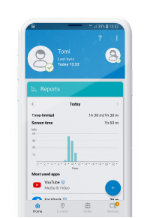ANIMALIA – Influencers
Do influencers always have good influence on children? Find out in the new episode of "Animalia", educational, interactive, animated series about child safety on the internet.
“Mom, why don't you ask me first if you can put my photo on Facebook?” Such questions are being asked by the generation of children whose photos have appeared on social networks without their permission. Blurred privacy lines are just one of the things these children now have to deal with. Another problem is the lack of control they have over their digital footprint.
From the privacy disruption to the potential material for bullying, today’s children might not thank their parents who had often posted pictures of them on social networks. Long before children can even learn what they want shared and what shouldn’t be public, their parents are already creating their social media presence.
What do we risk by doing that? As our children get older, they might turn against us with accusations that we have not allowed them to choose who they want to be—both in the digital and the real world.
Still wondering how sharing family pictures affects your child?
The Cons of Sharenting
In 2015, the average number of child pictures shared on social networks by their parents before they turned five was 973. Today, it is often more than 1,500, according to Parent Zone. Sharenting occurs when parents share private details about their child via digital channels without consent. This may negatively affect the well-being of the children and their further development.
Why? According to a survey at UCLA Digital Media Center, children ages 9-13 with their own social media accounts desire more fame than their peers. Children of sharing mothers also spend more time with social media, as they model the behavior of their parents.
Seeking likes, positive comments, and appreciation by an audience might easily become the main urge in their lives. In some cases, it can even open the door to various forms of physical or online exploitation, such as online theft of children's identities by individuals portraying the child as their own. Or even worse, it can end up in the hands of online predators and become an item of darkweb trading.
Where the right of parents to freedom of expression ends
Online information has the potential to remain permanently on the internet as our digital footprint.
If we realize today how much we can influence the digital footprint of our children, we can not only protect them from cyberbullying and other psychological issues. We can also positively influence their social status, as the digital citizens they are becoming today. We can help them decide what types of photos they want to share and what public image they would like to project.
If you share posts featuring your children, you are forming their digital footprint too. In addition, you co-create their digital identity.
What is a digital footprint?
| A passive digital footprint | An active digital footprint |
| Any information that a user leaves in the online space unknowingly and which is not directly visible. This can be the type of your browser, device model, language settings, operating system, or IP address, stored either in the internet provider’s database or the servers of your service provider. | All data knowingly provided and published on the internet – emails, blog posts, likes, comments, shared videos or texts on social networks and chat messages all becomes your active digital footprint. |
Source: ESET
If you can’t give up on posting photos of your kids from time to time, it is important to monitor your privacy settings of all the shared content. Always ask yourself questions like: Who has access to all my data? Can third parties view some of my information?
Also, avoid sharing any explicit pictures of your children, such as photos of your kids bathing. Such photos can be screenshotted or downloaded and sent to anyone, if not properly protected. And when it appears in a different context—such as on a child pornography site—it can lead to physical risks.
Not even the GDPR and its right to be forgotten can eliminate the risk of an embarrassing photograph being preserved on the hard drive of someone who has taken a screenshot. Despite being erased from the primary source, the information may reappear on the internet in the future and become a burden while complicating the user’s future job applications or making it difficult to start new relationships, states the ESET Digital Security Handbook for Teachers.
If you really want to share some information, use privacy settings that enable parents to select the specific audience for everything that is shared, and set up notifications to monitor where the posted information appears. According to the Child Rescue Coalition, 89% of parents haven't checked their privacy settings in over a year. So, if you haven’t done it yet, make sure you have everything set up correctly.
To conclude, there is no need to judge yourself too harshly. Interacting with people online has become even more important since the pandemic of Covid-19. Social media helped us keep in touch with thousands of remote friends. When used wisely, a few family photos aren’t likely to cause much damage—but it can’t hurt to ask your child first.


With ESET Parental Control for Android
Try free for 30 daysDo influencers always have good influence on children? Find out in the new episode of "Animalia", educational, interactive, animated series about child safety on the internet.
Posting mean comments on social media is not cool. Does your child know that? Enjoy "Animalia", educational, interactive, animated series about child safety on the internet.
Monique, Elias' classmate, is targeted by an anonymous online hater. What can Elias and Linda do to help her?